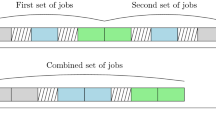Abstract
Workflow balancing helps to remove the bottlenecks present in a manufacturing system. A genetic algorithm (GA) is used to solve the parallel machine scheduling problem of the manufacturing system with the objective of workflow balancing. The performance of GA is compared with three workflow balancing strategies namely random (RANDOM), shortest processing time (SPT) and longest processing time (LPT). The relative percentage of imbalance (RPI) is adopted among parallel machines for evaluating the performance of these heuristics. The GA shows better performance for the combination of various job sizes and machines. A computer program has been coded on an IBM/PC compatible system in the C++ language for experimentation to a standard manufacturing system environment in operation.
Similar content being viewed by others
References
Rajakumar S, Arunachalam VP, Selladurai V (2004) Workflow balancing strategies in parallel machine scheduling. Int J Adv Manuf Technology 23:366–374
Farkas A, Koltai T, Stecke KE (1999) Workload balancing using the concept of operation types. Working Paper 99–002, Faculty research, The University of Michigan Business School, Ann Arbor, MI, USA, pp 1–23
Araujo EG, Dakin GA, Huber M, Grupen R (1995) Hierarchical scheduling of robotic assembly operations in a flexible manufacturing system. Int J Flex Automat Integr Manuf 3(3–4):301–316
Hayrinen T, Johnson M, Johtela T, Smed J, Nevalainen O (2000) Scheduling algorithms for computer aided line balancing in printed circuit board assembly. Prod Plan Control 11(5):497–510
Moon DH, Kim DK, Jung JY (2004) An operator load-balancing problem in a semi-automatic parallel machine shop. Comput Ind Eng 46:355–362
Pearn WL, Chung SH, Yang MH (2000) A case study on the wafer probing scheduling problem. Prod Plan Control 13(10):66–75
Hop NV, Nagarur NN (2004) The scheduling problem of PCBs for multiple non-identical parallel machines. Eur J Oper Res 158:577–594
Kumar N, Shankar K (2001) Comparing the effectiveness of workload balancing objectives in FMS loading. Int J Prod Res 39(5):843–871
Ghomi SMTF, Ghazvini FJ (1998) A pair wise interchange algorithm for parallel machine scheduling. Prod Plan Control 9(7):685–689
Potts CN, Whitehead JD (2001) Workload balancing and loop layout in the design of a flexible manufacturing system. Eur J Oper Res 129:326–336
Liang M, Dutta SP (1990) A mixed-integer programming approach to the machine loading and process planning problem in a process layout environment. Int J Prod 28:1471–1484
Tiwari MK, Vidyarthi NK (2000) Solving machine loading problems in a flexible manufacturing system using a genetic algorithm based heuristic approach. Int J Prod Res 38:3357–3384
Blackstone HG, Phillips ET, Hogg GL (1982) The state-of-art survey of dispatching rules for manufacturing job shop operations. Int J Prod Res 20(1):27–45
Tamaki H, Komori T, Abe S (1999) A heuristic approach to parallel machine scheduling with earliness and tardiness penalties. IEEE 5:1367–1370
Koulamas CP (1996) Scheduling two parallel semiautomatic machines to minimize machine interference. Comput Ops Res 23(10):945–956
Zhou H, Feng Y, Han L (1989) The hybrid heuristic genetic algorithm for job shops scheduling. Comput Ind Eng 40:191–200
Mokotoff E (2001) Parallel machine scheduling problems—a survey. Asia, Pac J Oper Res 18:193–242
Min L, Cheng W (1999) A genetic algorithm for minimizing the makespan in the case of scheduling identical parallel machines. Artif Intell Eng 13:399–403
Cheng R, Gen M, Tozawa T (1995) Minmax earliness/tardiness scheduling in identical parallel machine system using genetic algorithms. Comput Ind Eng 29:513–517
Cheng R, Gen M (1997) Parallel machine scheduling problems using memetic algorithms. Comput Ind Eng 33:761–764
McCormick ST, Pinedo ML (1995) Scheduling n independent jobs on m uniform machines with both flow time and makespan objectives: a parametric analysis. ORSA J Comput 7:63–77
Bean JC (1994) Genetic algorithms and random keys for sequencing and optimization. ORSA J Comput 6:154–160
Figielska E (1999) Preemptive scheduling with changeovers: using column generation technique and genetic algorithm. Comput Ind Eng 37:81–84
Serifoğlu SF, Ulusoy G (1999) Parallel machines scheduling with earliness and tardiness penalties. Comput Oper Res 26:773–787
Gen M, Cheng R (1997) Genetic algorithms and engineering design. Wiley, New York
Acknowledgements
The authors thank two anonymous referees for their extensive and valuable comments.
Author information
Authors and Affiliations
Corresponding author
Rights and permissions
About this article
Cite this article
Rajakumar, S., Arunachalam, V.P. & Selladurai, V. Workflow balancing in parallel machines through genetic algorithm. Int J Adv Manuf Technol 33, 1212–1221 (2007). https://doi.org/10.1007/s00170-006-0553-z
Received:
Accepted:
Published:
Issue Date:
DOI: https://doi.org/10.1007/s00170-006-0553-z




